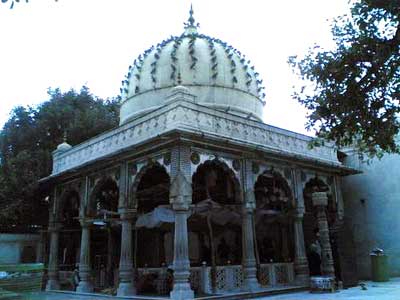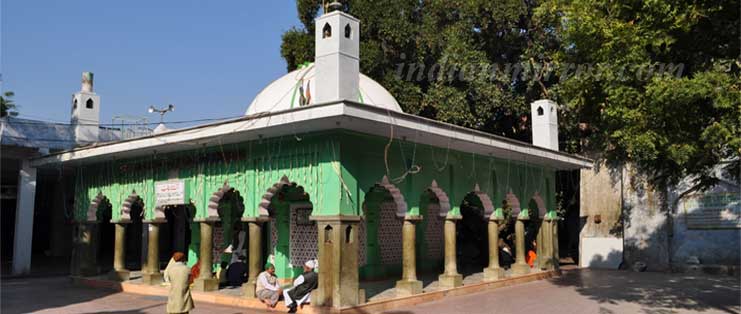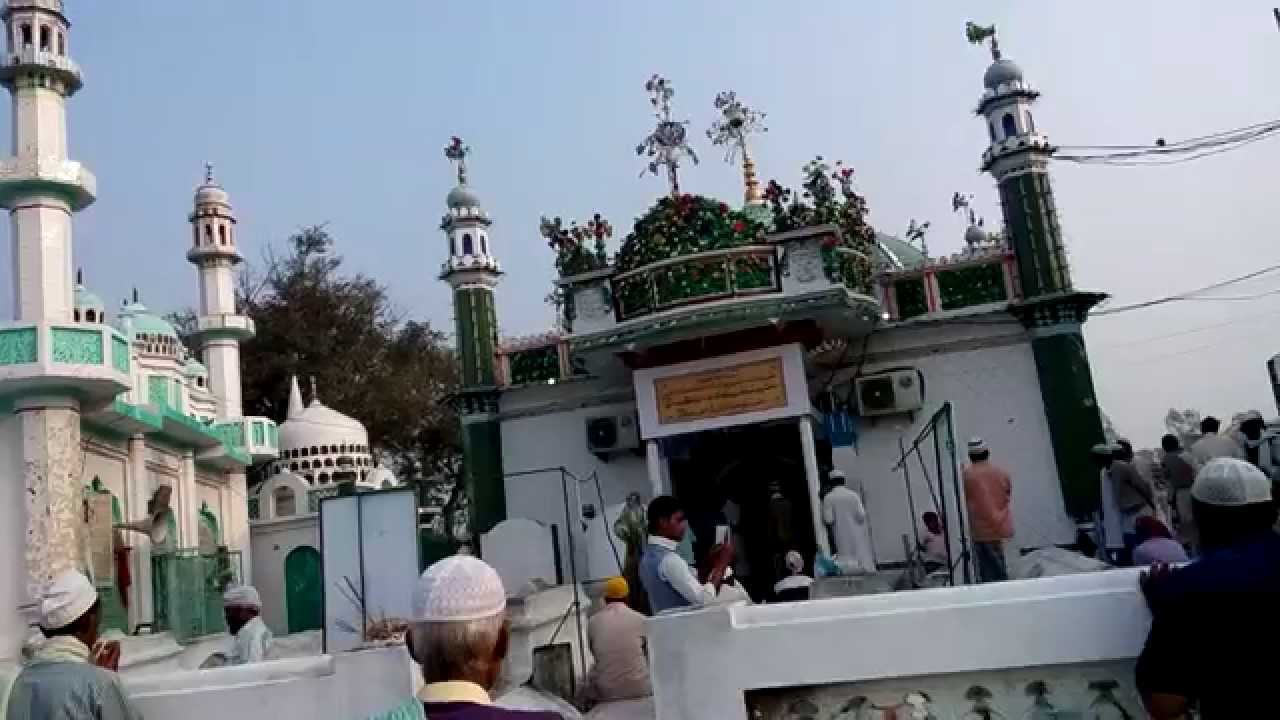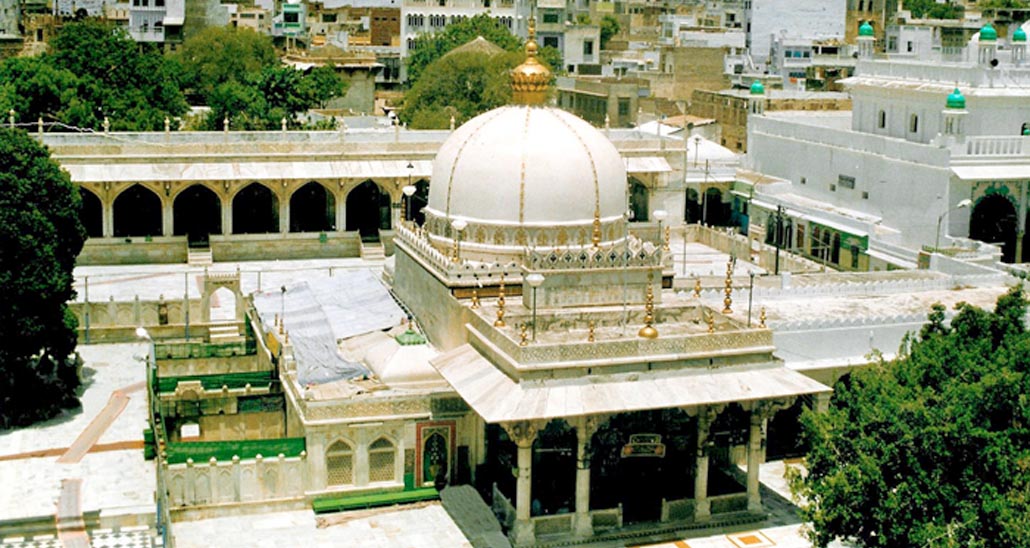Dargah Hazrat Moinuddin Chishti
Dargah of Hazrat Khwaja Moinuddin chishti is situated in the
city of Ajmer. Hazrat Khwaja Moinuddin Chishti, also known populary as
Gharib Nawaz was the founder of Chishti sect in India.
Khwaja Muinuddin Chishti, was born in Seistan (East Persia) also
known as Sajistan, around 533 Hijri (1138-39 A.D.) in a well respected family.
His father, Khwaja Ghayasuddin, r.a. and mother, Syeda Bibi Ummalwara (alias
Bibi Mahe-Noor), were the descendants of Hazrat Ali, r.a. through his sons
Imam Hassan and Imam Hussain. Khwaja Sahib lost both his father and mother
at an early age of sixteen years. He inherited an orchard and millstone which
were his means of livelihood. One day when Khwaja Sahib was working in his
orchard, a pious dervish and majzoob, Ebrahim Qandoozi, came and took his
seat under the shade of a tree. When Khwaja Sahib saw him, he brought a bunch
of grapes and presented it to his guest. The visitor ate the grapes and was
delighted. He then took something out of his bag, chewed it, then offered
it to his young host. Khwaja Sahib ate it without any hesitation, and at once
the light of wisdom and knowledge dawned upon the young Khwaja. Immediately
he disposed of all of his worldly belongings and distributed the money amongst
the poor. Having thus broken all the ties with worldly affairs, he set off
for Samarkand and Bokhara then the great centres of learning for religious
education and knowledge.
Khwaja Muinuddin Chishti, r.a., arrived in Ajmer at the age of 52 years
around 587 A.H. (1190 A.D.), on his divine mission, unique in the annals
of Islam. His only armour for the success of his great mission was the greatest
"invisible power" that pervades and sustains the whole universe. At that time,
Ajmer was ruled by Prithvi Raj Chauhan, the famous Rajput king. In his court,
he had a large number of powerful magicians with Ajai Pal as their leader.
Khwaja Sahib stayed on a hill close to Ana Sagar lake now known as the Chillah Khwaja Sahib. When the news spread that a
very pious Dervish had come to Ajmer, people began to flock to him in increasing
numbers. Whoever came to him, received the kindest treatment and blessings.
People were so much inspired by his divine teachings and simplicity that they
began to embrace Islam. Many became his disciples. Even Ajai pal submitted
himself to the divine powers of Khwaja Sahib, gave up all his magic and became
his disciple.

Dargah Hazrat Qutubuddin Bakhtiyar Kaki
Hazrat Khwaja Sayed Muhammad Bakhtiyar AlHussaini
Qutbuddin Bakhtiar Kaki's Dargah is situated in the city of Delhi in Mehrauli. Khwaja Qutubuddin Bakhtiyar was a Muslim Sufi mystic, saint and scholar
of the Chishti Order from Delhi. He was the disciple and the spiritual
successor of Moinuddin Chishti. Qutub Minar in Delhi is dedicated and
named after the name of Qutb ul Aqtab Hazrat Khwaja Sayed Muhammad
Bakhtiyar. Before him the Chishti order in India was confined to Ajmer
and Nagaur. He played a major role in establishing the order securely in
Delhi. His dargah is located adjacent to Zafar Mahal in Mehrauli and
the oldest dargah in Delhi, is also the venue of his annual Urs
festivities. The Urs was held in high regard by many rulers of Delhi
like Qutbuddin Aibak, Iltutmish who built a nearby step well, Gandhak ki
Baoli for him, Sher Shah Suri who built a grand gateway, Bahadur Shah
who built the Moti Masjid mosque nearby and Farrukhsiyar who added a
marble screen and a mosque.
His most famous disciple and spiritual successor was Fariduddin
Ganjshakar, who in turn became the spiritual master of Delhi’s noted
Sufi saint, Nizamuddin Auliya, who himself was the spiritual master of
Amir Khusro and Nasiruddin Chirag-e-Delhi.
Qutbuddin Bakhtiyar Kaki had much influence on Sufism in India. As he
continued and developed the traditional ideas of universal brotherhood
and charity within the Chisti order, a new dimension of Islam started
opening up in India which had hitherto not been present. He formed an
important part of the Sufi movement which attracted many people to Islam
in India in the thirteenth and fourteenth centuries. People of every
religion like Hindus, Christians, Sikhs, etc. visiting every week at
Dargah.

Dargah Hazrat Nasiruddin Roshan Chiragh
Hazrat Nasiruddin Mehmood, better known as Roshan Chiragh-e-Dehli (Illuminated Lamp of Delhi) ( 1274 AD-1356 AD) was a 14th century mystic-poet and a Sufi Saint of
Chishti Order. He was a murid (disciple) of noted Sufi saint, Hazrat
Nizamuddin Auliya RA, and khalifa, his successor He was the last important Sufi of Chishti Order from Delhi
He was given the title, "Roshan Chirag-e-Delhi", which in Hindi and Urdu, means "Illuminated Lamp of Delhi" by his Pir (Master) Hazrat Nizamuddin Aulia Mehboobe Elahi. His Dargah is situated in the city of Delhi.
Hazrat Nasiruddin Mahmood Chiragh Dehlavi (or Chiragh-e-Delhi) was born as Nasiruddin around 1274, at Ayodhya, Uttar Pradesh. His father Syed Yahya, who traded in Pashmina, and his grand father, Syed Abdul Latif,
first migrated from Khorasan, north-eastern Iran, to Lahore, and
thereafter settled in Ayodhya, in Awadh. His father died when he was
only nine years of age, thereafter growing up with his mother, he
received his early education from Maulana Abdul Karim Sherwani, and later continued it, with Maulana Iftikhar Uddin Gilani.
At age forty, he left Ayodhya for Delhi, where he became the disciple of Khwaja Nizamuddin Auliya,
it was here that he stayed for the rest of his life as his murid
(disciple) , and eventually after his death, became his successor. In
time, he also became a known poet in Persian language
He died in 17 Ramzan 757 Hijri or 1356 AD.at the age of 82, and is
buried in a part of Delhi, India which is known as "Chirag-e-Delhi"
after him .
One of his noted disciple was Khwaja Bande Nawaz Gesu Daraz,
who later moved to Daulatabad around 1398, owing to the attack of Timur
on Delhi, and from where at the invitation of Bahamani King, Firuz Shah
Bahamani, moved to Gulbarga, Karnataka, where he stayed for the
following 22 years of his life, spreading the Chishti Order in the South
till his death in November 1422. The Dargah of Khwaja Bande Nawaz, exists today in the city of Gulbarga, as a symbol, multi-religious unity.
During his stay in Delhi, he continued to visit Ayodhya often, where he
made a number of disciples, notably, Shaikh Zainuddin Ali Awadhi, Shaikh Fatehullah Awadhi and Allama Kamaluddin Awadhi.
After his death, his tomb was built by Firuz Shah Tughluq (r. 1351 -
1388), the Sultan of Delhi in 1358, and later two gateways were added on
either side of mausoleum. One of noted addition was a mosque built by a
later Mughal emperor, Farrukhsiyar, in early 18th century, and popular
among both Muslims and Non-Muslims. A humble tomb of the founder of
Lodhi dynasty, Bahlul Khan Lodhi (r.1451-89) lies close to the shrine in
the present day locality of ‘Chirag Delhi’ that grew around the tomb,
and is still goes by his name, it is very close to the locality of
Greater Kailash, in South Delhi.
Nasiruddin Chiragh Dehalvi, unlike his spiritual master Nizamuddin Auliya,
did not listen to sama, which was considered as unislamic by a section
of the Muslim intelligentsia in that period. He did not however pass any
specific judgement against it. This is the reason why even today,
qawwali is not performed near his shrine in Delhi. Hazrat Nasiruddin's
descendants are to be found far and wide as a lot of them moved down
South to Hyderabad. The Dargah of Badi Bua or Badi Bibi, who said be the
elder sister of Hazrat Nasir Uddin Mahmud Chiragh Dehlavi.
Initially, the main tomb was enclosed within rectangular walls, built of
rubble. This chamber was constructed by Muhammad Bin Tughlaq, who later
added a small gateway on both sides of the tomb. However, the original
Chiragh-I-Dili Dargah has undergone renovations and repairs a number of
times. Now, a twelve-pillared square chamber, enclosed within perforated
screens, consists of the tomb of Nasir-ud-Din Mahmud. The chamber has four small domed towers at the corners and is surmounted by a plastered dome, rising from an octagonal drum.

Dargah Hazrat Makhdoom Ashraf Simnani
It is situated in the village known as Kichocha in Uttar Pradesh. Hazrat Makhdoom Ashraf Jahangir Simnani was
born in the year 708 Hijri at Simnan in Persia. His father Hazrat Sultan
Sayyad Ibrahim Noor Bakhsh (ra) ruled the region for about 20 years. Apart from
being a noble and respected governor, he was also a great scholar, theologian and
Sufi. His mother, Bibi Khadijah Begum was also in the lineage of great mystics and
saints. She was very pious and is especially renowned for his namaaz-e-Tahajjud
regular. Hazrat Makhdoom (RA) was admitted to the Madrassah at the age of 4 years,
4 months and 4 days. And at the age of 5 years, he became Hafiz-e-Quraan with 7
ways to make the Qiraa'aat (reading) in a period of 7 months and 26 days, and he
completed his Islamic education at the age of 14 years.
He was proclaimed the 6th King of Simnan and ascended the throne at a very tender
age after the wafaat (death) of his father. During his reign he took the help of
Hazrat Sheikh Ala-ud-Dowla Simnan (ra) for his spiritual education and Shariah practiced
with all devotion and great detail in its ibaadats (prayers) without violating his
sunnat and Nafil in each namaz. He was very popular with his constituents. During
the same period, he saw in a dream the great wali Ouwaÿss Qarni Hazrat (ra)
who taught him the 'Marifat' (step spirituality). Also, the mystical creature, Hazrat
Khidr Aleh Salam the initiative to wazîfahs special and he left his throne
to devote himself full time to the path of Allah, saying he 's has never experienced
neither peace nor personal pleasure to be on a throne. He then took the road to
India courtesy of his mother. There, he met Hazrat Makhdoom Jalal-ud-Deen Jahânia
Jahangasht Bukhari (ra) and profited enormously from his spirituality during the
3 days spent in his company. This great Wali asked to go to Bengal where his true
spiritual guide, Hazrat Sheikh Alaul Haque Waddeen Gunje Nabaat (RA) awaited. En
route to his Murshid (spiritual guide), he arrived in Bihar where he was awaited
to lead the namaz e janazah of Hazrat Sheikh Sharf-ud-Deen Yahyah Moonîri
(ra) according to his will. Hazrat Ashraf (RA) performed the namaz Janaaza and at
the same time, according to this will he bore the coat 'Khilafat' of this great
Wali as a gift. Arrived in Bengal, he was greeted by his Murshid and others. After
the salaam and Musaffa (braces), his Murshid made him eat 4 bites of betel with
his own hand and Hazrat Makhdoom (ra) took the bai'at (spiritual commitment). It
was filled with spirituality during its 12 years in the company of his Murshid and
with his permission, he received the title of "Jahangir”, the dress and'
Khilafat '. It is from here that his mission began. Hazrat Makhdoom Ashraf Rahmatullahi alaih left this world on the 28th Muharram
808 A.H.





